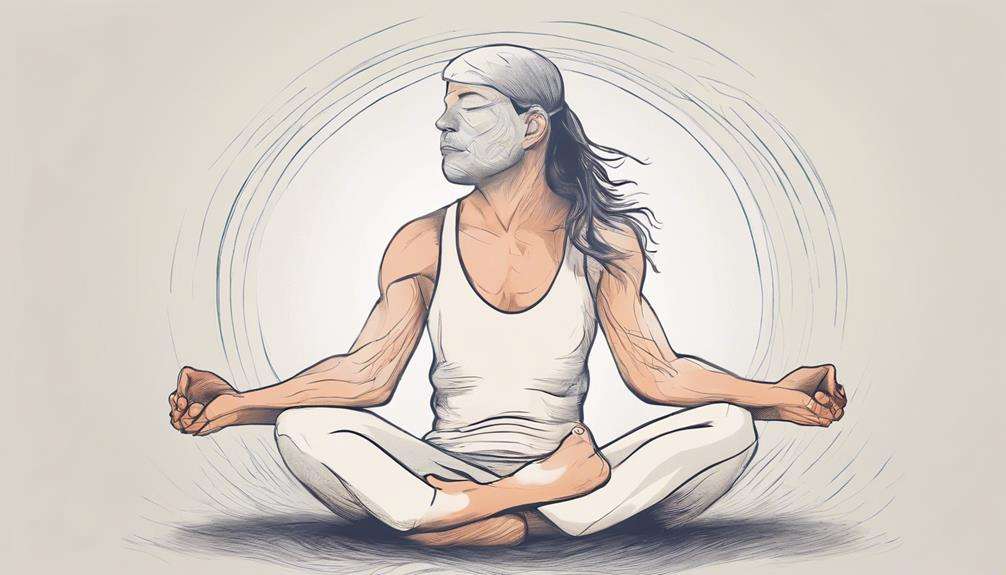Imagine a serene mountain lake at dawn, its surface calm and reflective.
As you explore the domain of meditation techniques for emotional well-being and blood pressure management, consider the profound impact they can have on your overall health.
From mindfulness practices to loving-kindness meditation, each method offers a unique pathway to inner peace and physical well-being.
Discover how these techniques can transform your daily life and contribute to a healthier, more balanced you.
Key Takeaways
- Breath-focused techniques improve emotional well-being and lower blood pressure.
- Compassion practices enhance resilience, reduce stress, and foster social connections.
- Visualization meditations cultivate inner peace, positivity, and reduce anxiety.
- Mind-body relaxation methods support emotion management, reduce stress, and improve cardiovascular health.
Mindful Breathing
Mindful breathing, a powerful technique for enhancing emotional well-being, involves focusing on your breath to cultivate awareness and relaxation. This practice is deeply rooted in meditation and is known for its ability to reduce stress, anxiety, and even lower blood pressure levels.
By consciously directing your attention to the inhalation and exhalation process, you can tap into a state of calm and present moment awareness. Research supports the benefits of mindful breathing in improving emotional well-being and promoting mental clarity.
Engaging in mindful breathing exercises for just a few minutes each day can have a significant impact on your overall emotional health and blood pressure management. By integrating this practice into your daily routine, you can experience a sense of relaxation and heightened awareness that contributes to a more balanced and centered state of being.
Embrace the power of mindful breathing to nurture your emotional well-being and cultivate a deeper sense of peace within.
Loving-Kindness Meditation
Loving-Kindness Meditation, or Metta, aims to nurture compassion, kindness, and love within you.
This practice involves sending positive intentions and well-wishes to yourself and others.
Cultivating Compassion Daily
To enhance your emotional well-being through daily practice, consider incorporating the cultivation of compassion as a core component of your meditation routine.
Loving-Kindness Meditation, also known as Metta, is a powerful practice that focuses on fostering compassion towards yourself and others. Research indicates that this form of meditation can effectively reduce stress, elevate positive emotions, and enhance overall well-being.
By engaging in Loving-Kindness Meditation, you may experience lower cortisol levels, the stress hormone, leading to improved emotional health. This technique involves the repetition of phrases conveying well wishes and extending kindness not only to yourself and loved ones but also to acquaintances and even challenging individuals.
Regular practice of Loving-Kindness Meditation has been associated with heightened feelings of social connection, empathy, and emotional resilience.
Sending Love to All
Incorporate compassion into your meditation routine by focusing on sending love to all through the practice of Loving-Kindness Meditation. This form of meditation, also known as metta meditation, centers on cultivating feelings of love, compassion, and goodwill towards yourself and others.
By repeating phrases of well-wishes and positive intentions, you can enhance positive emotions, reduce symptoms of depression and anxiety, and improve your overall emotional well-being. Loving-kindness meditation fosters a sense of interconnectedness and empathy, aiding in the development of emotional balance and resilience.
Regular practice has been linked to lower stress levels, increased happiness, and improved relationships with both yourself and those around you. Embrace this practice to nurture a kinder heart and a more peaceful mind.
Warmth Towards Self
Cultivating feelings of warmth and kindness towards yourself and others can be achieved through the practice of Loving-Kindness Meditation, also known as metta meditation. This technique focuses on generating sentiments of compassion and empathy by repeating positive phrases.
By engaging in Loving-Kindness Meditation, you can foster a sense of inner warmth and extend that kindness to those around you. Research indicates that regular practice of this meditation method can lead to reduced symptoms of depression, increased positive emotions, and improved social connections.
In addition, incorporating Loving-Kindness Meditation into your routine may enhance emotional well-being, decrease stress levels, and boost emotional resilience. By prioritizing self-compassion and empathy through this practice, you can contribute to not only your own mental wellness but also potentially lower your blood pressure by reducing stress.
Body Scan Meditation
By systematically focusing on different parts of your body, body scan meditation promotes relaxation and mindfulness. This practice helps you become more attuned to physical sensations, identifying areas of tension and stress.
By bringing awareness to these areas, you can release pent-up anxiety and stress, leading to a calmer state of mind. Body scan meditation is effective in reducing anxiety levels, improving sleep quality, and relieving muscle tension.
Regular practice of body scan meditation not only enhances overall well-being but also sharpens mental clarity. Studies indicate that incorporating body scan meditation into your routine may play a role in lowering blood pressure by alleviating stress and inducing a state of relaxation.
Yoga Nidra

Targeted focus from the body scan meditation practice, let's now explore the deeply relaxing technique of Yoga Nidra.
Yoga Nidra is a form of guided meditation known for inducing deep relaxation and reducing stress. During a Yoga Nidra session, you enter a state of conscious relaxation where your body rests in a state of calmness while your mind remains alert. This practice is highly effective in lowering blood pressure by calming the nervous system and decreasing the levels of stress hormones in your body.
Regular practice of Yoga Nidra not only helps in managing blood pressure but also enhances emotional well-being by promoting a sense of inner peace and tranquility. By engaging in this meditation technique, you can improve the quality of your sleep, reduce anxiety, and experience an overall boost in relaxation.
Whether you're a beginner or experienced in meditation, incorporating Yoga Nidra into your routine can be a valuable tool for achieving emotional balance and maintaining peak blood pressure levels.
Visualization Meditation
As you explore the practice of visualization meditation, you'll discover the power of inner peace visualization and healing imagery techniques.
By engaging in this practice, you can create a serene mental space that promotes emotional well-being and relaxation.
Through the art of visualization, you have the opportunity to cultivate a sense of tranquility and positivity within yourself.
Inner Peace Visualization
Engage your mind in creating serene and calming mental images through Inner Peace Visualization, a powerful technique of visualization meditation. By picturing tranquil settings or scenarios, you can effectively reduce stress and anxiety while enhancing your emotional well-being.
This practice focuses on immersing yourself in peaceful environments within your mind, fostering a sense of inner peace and relaxation. Cultivating these serene mental landscapes can lead to an improved mood and overall mental health.
Regularly incorporating Inner Peace Visualization into your routine may help you experience heightened levels of calmness and tranquility, potentially contributing to lower blood pressure levels.
Take a moment to visualize peace and serenity, allowing yourself to unwind and find solace in the soothing images you create.
Healing Imagery Practice
Utilize Healing Imagery Practice, also known as Visualization Meditation, to harness the power of detailed mental images for promoting relaxation and healing. Visualization Meditation is a technique that can aid in stress reduction, alleviate anxiety, and enhance emotional well-being by immersing yourself in positive scenes within your mind.
Studies indicate that regularly engaging in Visualization Meditation may not only improve mood and increase emotional resilience but also contribute to lowering blood pressure. By focusing on creating uplifting mental images, you can cultivate a sense of inner peace and optimism, empowering yourself to manage emotions effectively.
Embrace the practice of Visualization Meditation to take control of your emotional health and well-being, paving the way for a more serene and balanced life.
Progressive Muscle Relaxation

Progressive Muscle Relaxation, a technique involving the deliberate tensing and subsequent relaxing of specific muscle groups, is a proven method for reducing stress and anxiety levels while promoting emotional well-being. This relaxation technique, commonly known as PMR, is effective in reducing muscle tension, aiding in stress reduction, and enhancing overall relaxation. Research supports that PMR can also play a role in lowering blood pressure, making it a valuable tool in managing conditions like hypertension.
By practicing PMR regularly, individuals can become more attuned to their muscle tension levels, leading to better relaxation responses when faced with stressful situations. Additionally, the benefits of improved sleep quality and emotional well-being are often associated with the consistent practice of PMR.
Incorporating Progressive Muscle Relaxation into your routine can provide a practical and accessible way to enhance your overall health and well-being, offering a simple yet impactful method for managing stress and promoting relaxation.
Mantra Meditation
Incorporating mantra meditation into your daily routine can greatly contribute to enhancing emotional well-being by promoting relaxation and reducing stress. Mantra meditation involves the repetition of a specific word or phrase to focus the mind, calm the senses, and induce a state of tranquility. This technique has been proven to reduce stress, anxiety, and negative emotions, thereby improving emotional well-being.
Studies have shown that regular practice of mantra meditation can also have physical benefits such as lowering blood pressure and enhancing cardiovascular health over time.
Whether you choose a personalized mantra that holds personal significance or opt for a traditional one, the act of repetition helps quiet the mind, cultivate inner peace, and foster a sense of overall well-being. By incorporating mantra meditation into your daily routine, you can experience the profound effects of stress reduction, emotional balance, and mental clarity, leading to a healthier mind and body.
Guided Imagery

When practicing guided imagery, envisioning peaceful and calming scenes in your mind can effectively reduce stress and anxiety while promoting emotional well-being. This relaxation technique engages the senses in a positive mental experience, helping to lower blood pressure and improve cardiovascular health outcomes.
Research suggests that regularly incorporating guided imagery into your routine can enhance relaxation responses, potentially contributing to better blood pressure control. By combining guided imagery with other meditation practices, you can take a holistic approach to emotional well-being and lowering blood pressure.
Utilizing guided imagery as part of your meditation regimen offers a powerful tool for stress reduction and overall health improvement. Take time to immerse yourself in tranquil mental images during your practice to reap the full benefits of this technique on your emotional and physical well-being.
Walking Meditation
Engage in walking meditation by focusing on the sensations of walking, such as the movement of your feet and the rhythm of your breathing. This practice of mindfulness can greatly reduce stress levels and improve emotional well-being.
Studies have shown that walking meditation not only enhances mindfulness but also has positive effects on cardiovascular health, potentially lowering blood pressure. Taking your meditation practice outdoors and immersing yourself in nature can deepen the benefits by allowing you to connect with the environment around you.
Integrating walking meditation into your daily routines can be a simple yet effective way to promote physical activity, mental clarity, and relaxation. By incorporating this practice into your day, you can experience a holistic improvement in your overall well-being.
Gratitude Meditation

To enhance your emotional well-being and cultivate a positive outlook, consider practicing gratitude meditation to focus on feelings of appreciation and thankfulness for the positive aspects of your life. Gratitude meditation is a powerful technique that has been shown to reduce stress, enhance happiness, and lower blood pressure by decreasing cortisol levels, the stress hormone in your body. Research suggests that regular gratitude meditation sessions can help you develop a positive outlook, leading to improved mental health and emotional resilience.
Incorporating gratitude meditation into your daily routine can promote feelings of contentment, mindfulness, and inner peace. By taking the time to reflect on the things you're grateful for, you can shift your focus towards positivity and abundance, which can have a profound impact on your overall well-being. Embracing gratitude meditation as a part of your daily practice may not only improve your emotional health but also contribute to better blood pressure regulation and a more balanced physiological state.
Frequently Asked Questions
What Meditation Is Good to Lower Blood Pressure?
To lower blood pressure, try deep breathing, body scan, loving-kindness, guided imagery, mindfulness practice, progressive relaxation, or Zen meditation. These techniques promote relaxation and may help manage stress, supporting better blood pressure control and emotional well-being.
What Are Relaxation Techniques for Lowering Blood Pressure?
To lower blood pressure, try deep breathing, progressive relaxation, guided imagery, mindful movement, self-hypnosis, body scan, and yoga poses. These techniques can help you manage stress and improve your overall well-being effectively.
How Can I Lower My Blood Pressure With My Mind?
Focus on the mind-body connection by practicing breath awareness and mindfulness. Reduce stress, regulate emotions, and evoke the relaxation response. Enhance your hypertension management through mindful practices that promote emotional well-being and lower blood pressure.
How Does Transcendental Meditation Lower Blood Pressure?
When you practice Transcendental Meditation, your nervous system relaxes, reducing stress and improving your mind-body connection. This relaxation response leads to lower blood pressure, enhancing heart health and overall well-being through mindfulness, breathing exercises, and cognitive benefits.
Conclusion
Incorporating meditation techniques into your daily routine can be a soothing balm for the mind and body. From mindful breathing to loving-kindness meditation, these practices offer a path to emotional well-being and lower blood pressure.
Embrace the serenity of body scan meditation and the tranquility of yoga nidra. Let mantra meditation guide your inner peace and guided imagery transport you to a place of calm.
With gratitude meditation, cultivate a heart full of appreciation. Find solace in these practices for a healthier, happier you.






